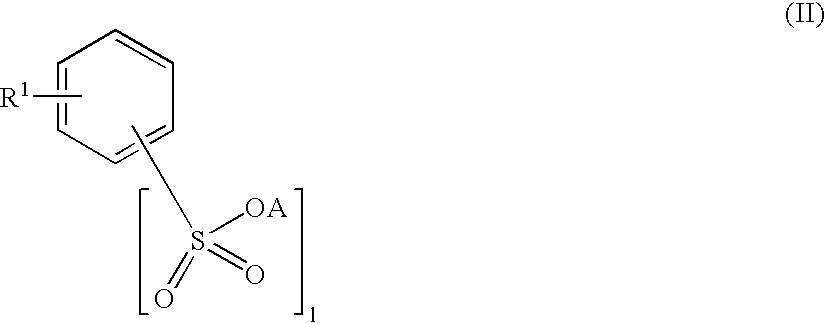Inhibition of catalytically active impurities in polycarbonate by the melt transesterification process
a technology of transesterification process and polycarbonate, which is applied in the direction of separation process, sulfur compound, chemical/physical/physicochemical process, etc., can solve the problems of ineffective thermal reduction of residual monomers at constant molecular weight, adversely affecting the effectiveness of additives, and low basic substances in polycarbonate, etc., to achieve rapid generation of large amounts of free acids, low solubility, and less volatile
- Summary
- Abstract
- Description
- Claims
- Application Information
AI Technical Summary
Benefits of technology
Problems solved by technology
Method used
Image
Examples
examples
[0139] The relative solution viscosity is determined in dichloromethane at a concentration of 5 g / l at 25° C.
[0140] The content of phenolic OH is obtained by IR measurement. For this purpose, a differential measurement of a solution of 2 g of polymer in 50 ml of dichloromethane compared with pure dichloromethane is carried out, and the difference in extinction at 3582 cm−1 is determined.
[0141] GMS is understood as meaning a mixture of glycerol monopalmitate and glycerol monostearate.
[0142] The total GMS content is composed of free GMS (GMSfree), GMS carbonate (GMS-CO3) and incorporated GMS. The latter is calculated by difference formation. A portion of the sample is subjected to alkaline hydrolysis at 80° C. and then adjusted to about pH 1 using hydrochloric acid. This solution is extracted with tert.-butyl methyl ether and the extract is dried. After derivatization, analysis is carried out by gas chromatography on a capillary column in conjunction with a flame ionization detecto...
example a
Synthesis of Inhibitor A
[0151]
[0152] 552.6 g (6.0 mol.) of glycerol from KMF and 4746 g (60 mol.) of pyridine from Aldrich are placed under nitrogen and dissolved homogeneously. 3196.8 g (18.1 mol.) of benzenesulfonic acid chloride are added dropwise very slowly, during which the temperature should not exceed 30-35° C. Stirring is then carried out for one hour at 40° C.
[0153] Working up:
[0154] The batch is added very slowly to a mixture of 3 litres of distilled water, about 4 kg of ice and 3 litres of dichloromethane, with vigorous stirring. During the addition, a temperature of 35° C. should not be exceeded.
[0155] The organic phase is then precipitated in about 10 litres of methanol, filtered off with suction and washed with methanol until thin-layer chromatography indicates that the product is clean.
[0156] Drying is then carried out to constant weight in a vacuum drying cabinet at 60° C.
[0157] Yield: 970 g (31.54% of theory) of white powder
[0158] Analysis:
[0159] melting po...
example 1
[0160] 2.5 ppm of inhibitor A, based on the amount of polycarbonate used, are added to the starting polycarbonate A, and the mixture is rendered inert with nitrogen and a vacuum. The sample is immersed in a bath which has been pre-heated to 300° C. and is melted for 20 minutes under a high vacuum, without stirring. As soon as the sample has melted, the stirrer is switched on and a small amount of sample is removed. Stirring is carried out for a further 2 hours, small samples being taken after 30, 60 and 120 minutes.
[0161] The relative viscosity and the residual monomer content of these samples are determined (Table 1).
PUM
| Property | Measurement | Unit |
|---|---|---|
| pressures | aaaaa | aaaaa |
| pressures | aaaaa | aaaaa |
| temperatures | aaaaa | aaaaa |
Abstract
Description
Claims
Application Information
 Login to View More
Login to View More - R&D
- Intellectual Property
- Life Sciences
- Materials
- Tech Scout
- Unparalleled Data Quality
- Higher Quality Content
- 60% Fewer Hallucinations
Browse by: Latest US Patents, China's latest patents, Technical Efficacy Thesaurus, Application Domain, Technology Topic, Popular Technical Reports.
© 2025 PatSnap. All rights reserved.Legal|Privacy policy|Modern Slavery Act Transparency Statement|Sitemap|About US| Contact US: help@patsnap.com



